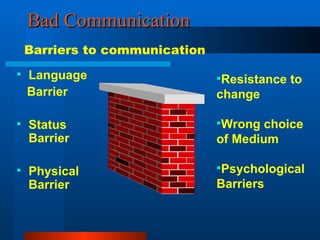Communication The Rationale V1
- 2. Family Neighbors Subordinate Friends Colleague Boss Acquaintance Fellow Travelers Groups Groups Groups Groups Organisation Have you ever thought !! Relationship Building Influence Others Achieve Objectives To be Effective
- 3. Definitions Communication comes from a Latin verb ‘Communicare’ which means to impart, to participate, to share or to make common Communication is the process by which two or more persons come together to exchange ideas and understanding amongst themselves’ ( Koontz and O’Donnell )
- 4. How Much to communicate Most of the Inter-personal problems are because of improper communication. Has to be most appropriate and just Under communication…….. Over Communication……… Mis-communication-Conflict, mis-understanding, inaction, wrong action etc…etc.
- 5. Why Communication INDIVIDUALS To share knowledge and information To build relations with Individuals To express emotions to others To present ideas- to be aptly understood To influence others of ideas/opinions To transact any deals/ Business needs etc. etc.,
- 6. Why Communication (contd..) GROUPS To achieve common goals/cause To reach a common understanding To ensure the group for effective completion of a task To share common values/ systems To build relationships To Work/progress with common interests
- 7. Why Communication (Contd.) Organisational Communication Achieve Coordinated Action *Organisational Goals *Share Information *Task Directives *Result of Efforts *Decision Making Express Feelings and Emotions
- 8. Types of Communication Informal - Grapevine is the informal channel of communication amongst people which flows around water coolers, down hallways, through lunch rooms and wherever people get together in groups. Does not always carry complete information Feedback reaches the managers faster Not very dependable Transmits information at fast speed Information may be distorted It draws the worker near to each other Disadvantages Advantages
- 9. Communication Networks Wheel Chain Circle Manager Subordinate Subordinate Subordinate Subordinate Task force Member Task force Member Task force Member Task force Member Informal Group Member Informal Group Member Informal Group Member Informal Group Member All Channel Senior Manager Manager Assistant Manager Management Trainee
- 10. Bad Communication Language Barrier Status Barrier Physical Barrier Resistance to change Wrong choice of Medium Psychological Barriers Barriers to communication
- 11. 5 Cs of Good Communication Conciseness Write the message in as few words as possible Completeness Ensure that all the information needed by the reader to respond or act is included Courtesy Show consideration for the receiver Clarity Write clearly Correctness Check the letter for accuracy of all statements and details
- 12. Brain Storm- Essential of Good Communication TEAM –A-Mediums of Comminication E-Mail,Telecon,Gp.Discussion Technical Presentation, NB, Intranet, Internet, Meetings, circulars, Posters, Group exercises songs TEAM-B Various Attributes of a Good Communication
- 13. Essentials of Good Communication Verbal Vocabulary and Usage Pronunciation Courtesy Three stages Tell them what you are going to tell them Tell them Tell what you have told them Physical Quality of Speech ABC- Accuracy, Brevity, Clarity KISS-Keep it short and simple
- 14. Essentials of Good Communication Non-Verbal Communication BODY -LANGUAGE Posture Relaxed, open, Comfortable on both feet Gestures Reaches out Expressions Attentive and Interested Eye Contact Direct, looks at everyone VOICE Voice Appropriate, Modulates Rate of Speech Moderate, Varies Verbal Clues “I think” “I feel” “What are our options”
- 15. Essentials of Good Communication Listening Listening is not the simple ability to decode information; it is a two way exchange in which both parties involved must always be receptive to the thoughts, ideas and emotions of the other person. Please Listen to Others Look Interested what they are saying is important and means a lot to you Inquire with questions right and relevant use of technique Stay on target be attentive Evaluate the message, read between the lines Neutralise your feeling emotional leakage/ biases/ prejudices/perceptions/ selective listening
- 16. Tools of Communication Body Language Body Expressions: Eyes, Face, Arms, Movements Listenning skills Presentation styles be constantly improved Customisation: Know the Audience. Language, tone , style, feelings, courtsy etc. Content: Prepare, Prepare and prepare
- 17. Feed Back Feed Back is a mechanism by which the sender reconfirms the receivers understanding of the message. This is essential with a view to ensuring that the communication is properly understood the way it was meant to be Essentials of Good Communication
- 18. Disadvantages of Bad Communication Can be Misunderstood and can lead to Conflicts May not be taken seriously loose control Reduced effectiveness and loose focus Can lead to loss opportunity/friends/goal
- 19. Advantages of Good Communication Would be understood properly Ability to handle any situations Ability to lead others coorectly Willingness of others to be lead by you Helps in easy decision making Helps in reducing and resolving conflicts Personality with a difference
- 20. How to be effective in communication Self Clarify objective - Inform - Understand - Perform - Transform Practice proper expression – Written, Verbal, Non-verbal Learn to Listen Learn to empathise Learn to deal with emotions Watch your tongue Be gentle – People are fragile Learn to use feed backs effectively Learn to apologise if you have communicated wrongly
- 21. How to be effective in communication As a Group Member Always keep the objective of the group in mind Listen and appreciate others point of view Clarify Assumptions Communicate your views, ideas truthfully but softly Record points depending on the importance of subject, for future reference Use feedback
- 22. In an Organisation Identify the receiver – whether to an individual, a group/ Dept. or all Be clear and avoid ambiguity Ensure physical receipt of communication Use feed back Be proactive in communicating Avoid distractions Use grapevines positively How to be effective in communication
- 23. Communication–A Continuous Process Communication at all times must be WIN-WIN Communication Effective Communication Action for Effective Communication Antithesis Synthesis Thesis






















